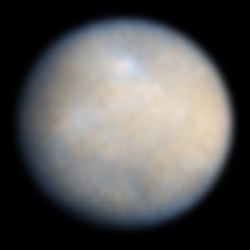In our discussion of possible new locations for human habitation in the solar system, I neglected one candidate which bears consideration. Especially given the fact that Saturn's tiny moon Enceladus "made the cut", the dwarf planet Ceres should at least be considered.
We don't know a great deal about Ceres, yet. We will know a great deal more in February of 2015 when the Dawn spacecraft arrives there, after its flyby of Vesta. Here's what we do know, compared to Enceladus:
Ceres Enceladus
Size (Diameter) 943 km 504 km
Gravity 0.03g 0.01g
Distance from Earth 250,000,000 km 1,500,000,000 km
So, Ceres is about twice the diameter of Enceladus, with three times the gravity (although it is still minute: a 200 lb person on Ceres would weigh 6 lbs on Ceres as opposed to 2 lbs on Enceladus), and Ceres is about five and a half times closer than Enceladus. Like Enceladus and Callisto, Ceres has water ice on her surface and likely liquid water below this. Unlike Enceladus, Ceres also has substantial amounts of carbonaceous rock on its surface, which could potentially be utilized as building materials.
Star Wars fans may balk at the idea of establishing a colony or outpost in the middle of an asteroid field, but the asteroid population of the Main Belt is actually quite sparse, and the asteroids are all orbiting the sun in similar ways so that the relative motion of any two adjacent Main Belt asteroids is very small. The greater risk is from solar radiation, which Ceres, unlike the surfaces of Enceladus or Callisto, is completely unprotected from by Saturn's or Jupiter's magnetospheres.
So, for all intents and purposes, Ceres completes the list of likely candidates for human settlement in the solar system in the near future.
For the record, See Threepio was a pessimist. The actual odds of a spaceship accidentally colliding with an asteroid in the Main Belt are less than one in one billion.


No comments:
Post a Comment